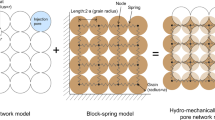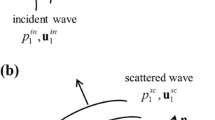Abstract
This paper presents a simple and convenient rectangular fractal micromixer, called imitate Cantor structure (ICS). According to the principle of enhancing chaotic advection and folding fluid, it can produce better mixing performance. We study this new structure that a geometry microchannel is designed with reference to the Cantor structure. Simulations is researched using multi-physics field simulation software COMSOL 5.2a based on finite element theory. This paper will compare with fractal obstacle number, fractal obstacle series, fractal obstacle height, fractal obstacle spacing, as well as at various flow velocities. The results indicate that as the flow velocity increase, the mixing performance shows a V-type trend. Through observation of fluid flow in microchannel, we clearly see the chaos vortex promotes the mixing of the fluid. After multiple comparisons, we select the best structure to form the ICS micromixer.




















Similar content being viewed by others
References
Bhagat AAS, Peterson ETK, Papautsky I (2007) A passive planar micromixer with obstructions for mixing at low Reynolds numbers. J Micromech Microeng 17(5):1017
Chau JLH, Leung AYL, Yeung KL (2003) Zeolite micromembranes. Lab Chip 3(2):53–55
Chen X, Li T (2017) A novel passive micromixer designed by applying an optimization algorithm to the zigzag microchannel. Chem Eng J 313:1406–1414
Chen X, Shen J (2017) Numerical analysis of mixing behaviors of two types of E-shape micromixers. Int J Heat Mass Transf 106:593–600
Hong CC, Choi JW, Ahn CH (2001) A novel in-plane passive micromixer using Coanda effect. Micro Total Analysis Systems 2001. Springer, Amsterdam, pp 31–33
Jeon W, Shin CB (2009) Design and simulation of passive mixing in microfluidic systems with geometric variations. Chem Eng J 152(2):575–582
Lu LH, Ryu KS, Liu C (2002) A magnetic microstirrer and array for microfluidic mixing. J Microelectromech Syst 11(5):462–469
Niu X, Liu L, Wen W et al (2006) Active microfluidic mixer chip. Appl Phys Lett 88(15):153508
Oddy MH, Santiago JG, Mikkelsen JC (2001) Electrokinetic instability micromixing. Anal Chem 73(24):5822–5832
Park J, Shin SM, Huh KY et al (2005) Application of electrokinetic instability for enhanced mixing in various micro–T-channel geometries. Phys Fluids 17(11):118101
Sritharan K, Strobl CJ, Schneider MF et al (2006) Acoustic mixing at low Reynolds numbers. Appl Phys Lett 88(5):054102
Tofteberg T, Skolimowski M, Andreassen E et al (2010) A novel passive micromixer: lamination in a planar channel system. Microfluid Nanofluid 8(2):209–215
Wang GD, Hao L, Cheng P (2009) An experimental and numerical study of forced convection in a microchannel with negligible axial heat conduction. Int J Heat Mass Transf 52:1070–1074
Warren TL, Krajcinovic D (1995) fractal obstacle models of elastic–perfectly plastic contact of rough surfaces based on the Cantor set. Int J Solids Struct 32:2907–2922
Warren TL, Majumdar A, Krajcinovic DA (1996) A fractal obstacle model for the rigid-perfectly plastic contact of rough surfaces. J Appl Mech Trans ASME 63:47–54
Whitesides GM (2006) The origins and the future of microfluidics. Nature 442(7101):368–373
Acknowledgements
This work was supported by The Key Project of Department of Education of Liaoning Province (JZL201715401), Liaoning Province BanQianWan Talent Project. We sincerely thank Prof. Chong Liu for his kind guidance.
Author information
Authors and Affiliations
Corresponding author
Additional information
Publisher's Note
Springer Nature remains neutral with regard to jurisdictional claims in published maps and institutional affiliations.
Rights and permissions
About this article
Cite this article
Wu, Z., Chen, X. A novel design for passive micromixer based on Cantor fractal structure. Microsyst Technol 25, 985–996 (2019). https://doi.org/10.1007/s00542-018-4027-7
Received:
Accepted:
Published:
Issue Date:
DOI: https://doi.org/10.1007/s00542-018-4027-7




